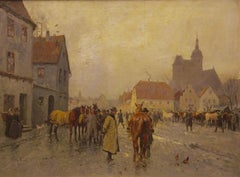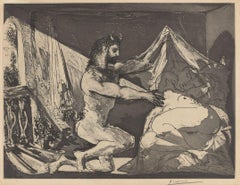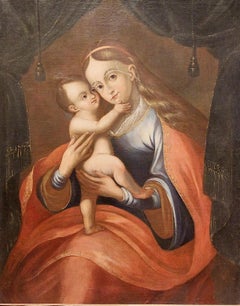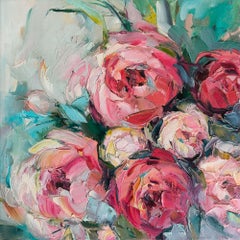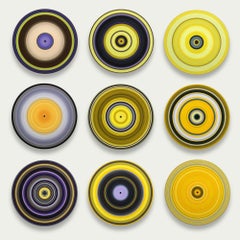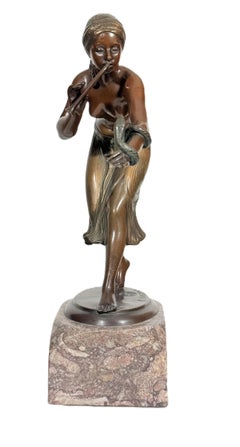Berlin - Art
to
203
182
140
100
85
110
Overall Width
to
Overall Height
to
15
108
210
284
16
21
10
9
12
11
10
15
20
15
11
121
64
63
44
14
14
13
10
7
3
2
1
1
287
193
59
285
143
126
99
89
48
45
42
41
40
33
31
30
30
28
25
23
19
19
15
401
219
218
202
175
33
25
13
11
8
106
7
232,714
151,405
Item Ships From: Berlin
Georg Koch 1857-1936, "At the horse market" Oil on canvas circa 1900
By Georg Koch
Located in Berlin, DE
Large, enticing and very decorative painting.
Oil on canvas. Signed lower left. G. Koch. (Georg Koch)
Motive of a lively horse market.
Beautiful paintin...
Category
Early 1900s Impressionist Berlin - Art
Materials
Canvas, Oil
Faune Dévoilant une Dormeuse
By Pablo Picasso
Located in Berlin, DE
Signed in pencil lower right 'Picasso'. Plate 27 of the 'Suite Vollard'. One of 250 impressions. Paris, Édition Vollard, 1939. On Montval-wove paper watermarked 'Vollard'. One of th...
Category
1930s Berlin - Art
Materials
Aquatint, Black and White
18th Century, Antique Oil Painting, Old Master. Portrait of Mother with child.
Located in Berlin, DE
18th century, antique painting, oil on canvas, old master. Mother with child.
Relined canvas.
Stretcher frame also renewed.
Artist unknown.
Category
18th Century Old Masters Berlin - Art
Materials
Canvas, Oil
$5,669 Sale Price
20% Off
Peonies. Floral original painting
Located in Zofingen, AG
"Peonies" is a vibrant and expressive painting that captures the beauty and delicacy of blooming peonies. Created with bold, sweeping brushstrokes and a vivid palette, this artwork b...
Category
2010s Modern Berlin - Art
Materials
Canvas, Oil
SOUND AND VISION – You called me mellow yellow B by Doris Marten - Installation
By Doris Marten
Located in Paris, FR
SOUND AND VISION – You called me mellow yellow (9 pieces, B) is a unique oil on vinyl installation by German contemporary artist Doris Marten, dimensions are 100 × 100 cm (39.4 × 39....
Category
2010s Contemporary Berlin - Art
Materials
Oil
Rudolf KAESBACH (1873-1955) Bronze Jugendstil
By Rudolf Kaesbach
Located in Berlin, DE
Rudolf KAESBACH (1873-1955), "Snake Charmer"
Inscribed 'R. Kaesbach' on the plinth and with the foundry mark, height with base: approx. 30.2 cm
Founding mark RM
Rosenthal & Maeder ...
Category
Early 20th Century Berlin - Art
Materials
Bronze
I Dreamed of You
Located in Zofingen, AG
The painting "I Dreamed of You" offers a refined exploration of human sensuality and emotional experiences. At the center of the composition is an elegant woman with a confident gaz...
Category
2010s Modern Berlin - Art
Materials
Canvas, Oil
Pink overflow. Abstract painting
Located in Zofingen, AG
This artwork is created using the liquid acrylic technique on canvas. The color palette ranges from soft purple and lilac shades to deeper, rich burgundy and red tones. The painting ...
Category
2010s Abstract Berlin - Art
Materials
Canvas, Acrylic
$472 Sale Price
20% Off
Florentine singer / - The Renaissance of the Renaissance -
By Paul Dubois
Located in Berlin, DE
Paul Dubois (1829 Nogent-sur-Seine - 1905 Paris), Florentine singer, 1865. Light brown patinated bronze with cast round plinth mounted on a square marble base (3.5 cm high). Total height 53 cm. Bronze dimensions: 49.5 cm (height) x 20 cm (length) x 10 cm (width), weight 5.6 kg. Inscribed on the plinth "P.[aul] DUBOIS", dated "1865", with the foundry's mark "F. BARBEDIENNE FONDEUR" and the signet "REDUCTION MECANIQUE A. COLLAS".
- Patina very occasionally darkened, lute with loss of one tuning peg, otherwise in excellent condition.
- The renaissance of the Renaissance -
The bronze is a precisely executed and masterfully cast contemporary reduction of Paul Dubois 155 cm tall masterpiece "Florentine Singer", which is exhibited in the Musée d'Orsay and for which the artist was awarded the Medal of Honor at the Paris Salon in 1865. The work acted as a beacon, and was followed by a plethora of depictions of juveniles.
Inspired by Donatello and Luca della Robbia, but also by painters such as Piero della Francesca, Benozzo Gozzoli, and Pinturicchio, the "Florentine Singer" is not an epigonal work that pays homage to a vanished era, but a successful attempt to draw vitality from the art of the past and thus give it new life.
The effect of vitality is the core of Italian Renaissance art theory. In order to fulfill itself as art, art had to appear like nature. This naturalism also characterizes the "Florentine Singer". The young man appears to have been taken from life, which is reinforced by the momentary nature of his action. He has just struck a now fading chord. In addition, the natural appearance is enhanced by the detailed shaping of the figurative details, such as the laces with the slightly curved leather of the shoes, the belt buckle, or the ornamentation on the body of the lute. Even the fingernails are clearly defined. Unlike the Renaissance, however, the effect of liveliness here is not based on the "discovery" of nature and the human body, but primarily on the rediscovery of the art of the Quattrocento. The liveliness of the artwork is therefore at the same time a revitalization of this art, so that we can speak of a Renaissance of the Renaissance, just as the Pre-Raphaelites in England at the same time transferred the Quattrocento to contemporary art.
Dubois takes on the most difficult of all subjects, the depiction of singing through silent sculpture. He was preceded in this by Luca della Robbia and Donatello with their pulpits of singers created in the 1430s in the Museo dell'Opera del Duomo in Florence. Compared to these works, the physiognomy of Dubois singer is far less animated, yet he also depicts singing in a convincing manner. He uses the whole body. He takes the ancient contrapposto, which was essential to Renaissance sculpture, and transforms the standing leg-playing posture into a late medieval S-swing, giving the body an elegant beauty and at the same time setting it in melodic motion. In the equally elegant finger position, the music is expressed in a much more literal way with the beating of the lute. Finally, the musicality of the sculpture culminates in the face with the mouth open to sing.
Through the act of singing, which is a great challenge to the artistic will to depict perfect beauty, the gracefulness of the classical face is not diminished, but enhanced. Starting from the face with the singing mouth and the gaze absorbed by the sounds, the inner vitality spreads, giving the bronze sculpture an intense aura, enhanced by the music. Dubois transfers the beauty of the Renaissance to the musical, sublimating the visible sculpture to the invisible of music.
He took up the challenge of transcending the Renaissance with the Renaissance, thus responding to the Querelle des Anciens et des Modernes, which arose at the end of the 17th century around the French Academy and remained virulent into the 19th century, in which antiquity was regarded either as an unattainable ideal or as a standard to be surpassed. With his work, Dubois proved that the Renaissance, which had championed the art of the ancients, could lead to a new renaissance of art.
About the artist
Paul Dubois' great-uncle was the famous French Baroque sculptor Jean-Baptiste Pigalle, in whose footsteps the talented great-nephew followed. When he debuted at the Paris Salon in 1858, he signed his work "Dubois-Pigalle". At his father's request, however, he first studied law before devoting himself to sculpture under the tutelage of François Christophe Armand Toussaint in 1856 and entering the École des Beaux-Arts in 1858. From 1859 to 1863, he lived in Rome and traveled to Naples and Florence. Inspired by Florentine art of the quattrocento, Dubois initiated a school-forming neo-Florentine style that combined the elegantly simple forms of youthful grace with a precise wealth of detail.Two purchases by the French state (“envois de Rome”) were made during his stay in Rome, which brought him recognition in Paris. After his return there, he quickly became an internationally sought-after artist.
Dubois was also active as a creator of monuments. His most famous work is the equestrian statue of Joan of Arc (1896) on the forecourt of Reims Cathedral. He was also a sought-after portraitist who produced around 50 busts and - Dubois was also a passionate painter - around 100 portraits in oil.
From 1873 to 1878 he was curator of the Museum du Luxembourg, in 1876 he became a member of the Institut de France and from 1878 to 1905 he was director of the École des Beaux-Arts.
In 1865, Dubois was awarded the Paris Salon Medal of Honor for his “Florentine Singer”. In 1867 he became Chevalier, in 1874 Officier, in 1886 Commandeur of the Légion d'honneur, which awarded Dubois the Grande Croix in 1896.
Selected Bibliography
Stole, Elmar: Paul Dubois. In: Saur. Allgemeines Künstlerlexikon, vol. 30, Munich - Leipzig 2001, pp. 677-678.
GERMAN VERSION
Paul Dubois (1829 Nogent-sur-Seine - 1905 Paris), Florentinischer Sänger, 1865. Hellbraun patinierte Bronze mit gegossener runder Plinthe auf quadratischem Marmorsockel montiert (3,5 cm Höhe). Gesamthöhe 53 cm. Maße der Bronze: 49,5 cm (Höhe) x 20 cm (Länge) x 10 cm (Breite), Gewicht 5,6 kg. Auf der Plinthe mit „P.[aul] DUBOIS“ bezeichnet, auf „1865“ datiert, mit dem Gießereistempel „F. BARBEDIENNE FONDEUR“ und dem Signet „REDUCTION MECANIQUE A. COLLAS“ versehen.
- Patina sehr vereinzelt nachgedunkelt, Laute mit Verlust eines Stimmwirbels, ansonsten ausgezeichnet erhalten.
- Die Renaissance...
Category
1860s Realist Berlin - Art
Materials
Bronze
$4,255 Sale Price
20% Off
Evening tea
Located in Zofingen, AG
Evening Tea" is a painting permeated with soft light and the aroma of a summer garden. Lush flowers in a vase seem to whisper stories of quiet evenings, and a cup of tea standing ne...
Category
2010s Modern Berlin - Art
Materials
Canvas, Acrylic
Tree of Life 1. From the series Tree of Life
Located in Miami Beach, FL
This series of paintings is part of a visual journey into our relationship with forests, jungles and the sacred Tree of Life.
Through painting and sculpture, Gregory Robin conveys t...
Category
2010s Abstract Berlin - Art
Materials
Canvas, Acrylic
Performance by members of the Deutsches Theater zu Berlin / - Ornamental Flow -
By Emil Orlik
Located in Berlin, DE
Emil Orlik (1870 Prague - 1932 Berlin), Ensemble guest performance by members of the Deutsches Theater zu Berlin, 1899. Color lithograph on wove paper, 20 cm x 13.3 cm (image), 29.5 ...
Category
1890s Jugendstil Berlin - Art
Materials
Paper
Swan loyalty
Located in Zofingen, AG
I have always admired these birds, especially when they are in love. These birds are a symbol of love. The picture is made with acrylic on canvas.
The piece was photographed with a ...
Category
2010s Pop Art Berlin - Art
Materials
Canvas, Acrylic
Young Ballerina
Located in Zofingen, AG
This captivating painting portrays a young ballerina, delicately adjusting her pointe shoes. Dressed in a ballet tutu, she exudes grace and discipline. Th...
Category
2010s Modern Berlin - Art
Materials
Canvas, Oil
Layers Object No. 17 by Doris Marten - Abstract painting, minimalist, lines, ink
By Doris Marten
Located in Paris, FR
Layers Object No. 17 is a unique ink drawings on Alu-Dibond painting by contemporary artist Doris Marten, dimensions are 35 × 217 cm (13.8 × 85.4 in).
The artwork is signed, sold unf...
Category
2010s Contemporary Berlin - Art
Materials
Ink
Pink bubbles. Abstract painting
Located in Zofingen, AG
It is very interesting to observe the cells that are formed in this technique. And the combination of white, pink and burgundy looks very noble. Note: This painting is painted on can...
Category
2010s Abstract Berlin - Art
Materials
Canvas, Acrylic
$472 Sale Price
20% Off
Warm Evening with Tea
Located in Zofingen, AG
Warm Evening with Tea" is a painting permeated with soft light and the aroma of a summer garden. Lush flowers in a vase seem to whisper stories of quiet evenings, and a cup of tea s...
Category
2010s Modern Berlin - Art
Materials
Canvas, Acrylic
Lady with a dog for a walk
Located in Zofingen, AG
The painting depicts an elegant woman in a light jacket with voluminous hair, sitting in a relaxed pose. Her image is rendered in muted shades of gray, turquoise, and pink, which len...
Category
2010s Aesthetic Movement Berlin - Art
Materials
Canvas, Acrylic
ABSTRACT New Black White Ink Artwork by Contemporary Artist Joan Salo 2024
By Joan Saló
Located in Barcelona, Barcelona
At Escat Gallery we are committed to maintaining the highest standards of trust and professionalism for our collectors. Every artwork in our collection comes with a Certificate of Au...
Category
2010s Abstract Berlin - Art
Materials
Cotton Canvas, Ink, Acrylic
Ingress, Painting, Acrylic on Paper
By Karin Goeppert
Located in Yardley, PA
"Ingress" is an abstract artwork reminding of nature, a forest creek, summer. Because of the colours and the partial transparency it makes you think of a ...
Category
2010s Abstract Berlin - Art
Materials
Acrylic
Figurative Composition / - Expressive Signs -
Located in Berlin, DE
Max Neumann (* 1949 Saarbrücken) and Eta Bender (*1948 Heidelberg), Figurative Composition, around 1970. Mixed media on tracing paper, mounted on thin backing paper, 29.6 cm x 21 cm,...
Category
1970s Abstract Expressionist Berlin - Art
Materials
Paper
Oil painting, 19th century, river and mountain landscape.
Located in Berlin, DE
Oil painting, 19th century, river and mountain landscape.
Oil on canvas.
Illegibly signed.
Frame damaged.
Free shipping only without frame.
76 cm x 94.5 cm without frame.
Category
19th Century Berlin - Art
Materials
Canvas, Oil
$4,251 Sale Price
20% Off
ABSTRACT New Diptych Black White Ink Artwork Contemporary Artist Joan Salo 2024
By Joan Saló
Located in Barcelona, Barcelona
At Escat Gallery we are committed to maintaining the highest standards of trust and professionalism for our collectors. Every artwork in our collection comes with a Certificate of Au...
Category
2010s Abstract Berlin - Art
Materials
Cotton Canvas, Ink, Acrylic
Girl with a Kid / - Caresses of innocence -
By Ary Bitter
Located in Berlin, DE
Ary Bitter (1883 Marseille - 1973 Paris), Girl with Kid, around 1930. Green patinated bronze with cast plinth loosely mounted on a white-veined dark green marble base. Dimensions of the plinth: 5 cm (height) x 80 cm (length) x 24 (width), dimensions of the bronze 28 cm (height) x 72 cm (length) x 18 cm (width). Weight of the bronze 18.2 kg, total weight 39.2 kg. Signed “Ary Bitter.” on the plinth and stamped “L N Paris J L” by the foundry Les Neveux de Jacques Lehmann...
Category
1930s Art Deco Berlin - Art
Materials
Bronze
$8,503 Sale Price
20% Off
Adam and Eve / - United in Death -
Located in Berlin, DE
Hans Thoma (1839 Bernau - 1924 Karlsruhe), Adam and Eve, 1897. Algraph on strong wove paper, published by Breitkopf und Härtel in Leipzig as ‘Zeitgenössisches Kunstblatt Nr. 113’, 44...
Category
Early 1900s Realist Berlin - Art
Materials
Paper
Spear Fighter / - The Fighter's Concentration -
Located in Berlin, DE
Ludwig Eisenberger (active in Berlin between 1895-1920), Spear Fighter, around 1910. Brown patinated bronze with residual gilding on a cast terrain plinth with marble base (8 cm high...
Category
1910s Realist Berlin - Art
Materials
Bronze
The start of spring. Abstract.
Located in Zofingen, AG
The picture is painted in a vibrant colour combination and carries the positive energy of the birth of the new. Painted with a special acrylic technique that creates volume in each m...
Category
2010s Pop Art Berlin - Art
Materials
Canvas, Acrylic
Portrait of a woman. Flora
Located in Zofingen, AG
The painting “Flora” depicts a young woman in a serene and contemplative state with her eyes closed, symbolizing inner peace and connection with nature. Inspired by the Roman goddess...
Category
2010s Modern Berlin - Art
Materials
Canvas, Oil
ABSTRACT New Black White Ink Artwork by Contemporary Artist Joan Salo 2024
By Joan Saló
Located in Barcelona, Barcelona
At Escat Gallery we are committed to maintaining the highest standards of trust and professionalism for our collectors. Every artwork in our collection comes with a Certificate of Au...
Category
2010s Abstract Berlin - Art
Materials
Cotton Canvas, Ink, Acrylic
Tree of Life 2. From the series Tree of Life
Located in Miami Beach, FL
This series of paintings is part of a visual journey into our relationship with forests, jungles and the sacred Tree of Life.
Through painting and sculpture, Gregory Robin conveys t...
Category
2010s Abstract Berlin - Art
Materials
Canvas, Acrylic
Antique painting. "Kings from all over the world in Bethlehem". Christian scene.
Located in Berlin, DE
Huge and very decorative castle painting.
Antique oil painting. Probably 18th century.
"Kings from all over the world in Bethlehem".
Christian scene.
Canvas relined.
Big, heavy fr...
Category
18th Century Old Masters Berlin - Art
Materials
Canvas, Oil
Raoul Fançois Larche Patinated bronze figure of a woman
Located in Berlin, DE
FRANCOIS-RAOUL LARCHE 1860 SAINT-ANDRÉ-DE-CUBZAC - 1912 PARIS
Signed on the base with "RAOUL LARCHE," foundry mark "SIOT DECAUVILLE PARIS FONDEUR," and number "R 276."
Total height...
Category
Early 1900s Jugendstil Berlin - Art
Materials
Bronze
Ivan Sorokin. 1970 Winter landscape. Russian art Oil Painting.
By Ivan Sorokin
Located in Berlin, DE
Ivan Sorokin.
Honoured Artist of the RSFSR, People’s Artist of the USSR, Member of the USSR Academy of Arts, Winner of the I. E. Repin State prize.
Category
1970s Impressionist Berlin - Art
Materials
Oil, Cardboard
$29,526 Sale Price
21% Off
Gladiator ready for battle / - Ready for anything -
By Bruno Zach
Located in Berlin, DE
Bruno Zach (1891 Zhitomir - 1945 Vienna), Gladiator ready for battle, c. 1930. Blackish patinated bronze with silver-plated helmet, shield rim and shield pommel mounted on a fluted m...
Category
1930s Art Deco Berlin - Art
Materials
Bronze
The Victorious David / - The melancholy of the radiant hero -
Located in Berlin, DE
Henri Honoré Plé (1853 Paris - 1922 Paris), The Victorious David, around1890. Red-brown and brown patinated bronze with terrain plinth mounted on a round base. 42 cm (total height) x...
Category
1890s Realist Berlin - Art
Materials
Bronze
$1,795 Sale Price
20% Off
Goethe / - Goethe's Will -
Located in Berlin, DE
Hans Harders (1875 Mörel - 1955 Berlin), Goethe (bookend). Patinated brass mounted on a wooden base, 15 x 12 x 6 cm (depiction), 17 x 14.5 x 7 cm (with ba...
Category
1930s Art Deco Berlin - Art
Materials
Brass
$1,133 Sale Price
20% Off
Naked warrior with short sword / - The New Hercules -
Located in Berlin, DE
Hermann Volz (1847 Karlsruhe - 1914 ibid.), Naked warrior with short sword, c. 1935. Partially (?) patinated bronze with cast plinth mounted on a black marble base (6.8 cm high). 32....
Category
1930s Art Deco Berlin - Art
Materials
Bronze
Mother Happiness / - The ecstasy of maternal joy -
Located in Berlin, DE
Johannes Boese (1856 Ostrog - 1917 Berlin), Mutterglück, um 1910. Goldbraun patinierte Bronze auf gegossener rechteckiger Plinthe, montiert auf zweifarbigem Marmorsockel (9,5 cm Höhe...
Category
1910s Art Nouveau Berlin - Art
Materials
Bronze
$3,968 Sale Price
20% Off
Antique Oil Painting, Dog Portrait, 19th Century, signed and dated.
Located in Berlin, DE
Decorative, antique oil painting, dog portrait, 19th century, signed and dated.
Dimensions including frame.
Category
19th Century Berlin - Art
Materials
Canvas, Oil
$4,724 Sale Price
20% Off
Imre Goth, 1893-1982, Hungary, "Little lady with doll" Oil on canvas circa 1931
By Imre Goth
Located in Berlin, DE
Large, enticing and very decorative painting.
Oil on canvas. Signed Imre Goth 1931.
1931. Motif of an elgant, young girl with her doll.
Beautiful painting in impressionist style.
...
Category
Early 1900s Impressionist Berlin - Art
Materials
Canvas, Oil
$42,518 Sale Price
20% Off
Judith with the Head of Holofernes, Antique Oil Painting after Cristofano Allori
By Alessandro di Cristofano Allori
Located in Berlin, DE
Judith with the head of Holofernes, antique oil painting after Cristofano Allori.
Painting has been restored.
Dimensions without f...
Category
18th Century Old Masters Berlin - Art
Materials
Canvas, Oil
Eutrope Bouret (1833-1906) Psyché
By Eutrope Bouret
Located in Berlin, DE
Eutrope Bouret Bronze
Spyche
Eutrope Bouret (French, 1833-1906)
Late 19th century.
Signed on the base
Bouret (French, 1833–1906) was an important 19...
Category
19th Century Jugendstil Berlin - Art
Materials
Bronze
Pecheur / - Full of anticipation -
Located in Berlin, DE
Adolphe Jean Lavergne (1863-1928), Pecheur, c. 1900. Brown patinated bronze with rectangular cast plinth on a green marble base (3 cm high), total height with hinge 37 cm, width 9 cm, depth 8 cm, weight 2.9 kg, signed “Lavergne” on the plinth.
- Base with old drilling and a few oxidized areas, patina occasionally rubbed, somewhat stained in the folds.
- Full of anticipation -
This bronze is the larger, highly detailed version of the fisherman that made Parisian artist Adolphe Jean Lavergne famous. In preparation for fishing, the boy prepares his rod before heading out to sea. The attachment of the iron ring and the rope behind him suggest a quay wall and a boat moored there. However, the depiction is entirely focused on the actual action of the young fisherman: With equal skill and concentration, he bends a hook to connect it to the fishing line. The contrast with his casual clothing, the loose-fitting trousers, the open shirt with its "wild" folds, and, last but not least, the sun hat boldly perched on his neck, reinforces the impression of the attentive care with which he goes about his work. His gaze makes him appear absorbed, as if he has forgotten the world around him and yet he is visibly filled with anticipation of fishing.
GERMAN VERSION
Adolphe Jean Lavergne (1863-1928), Pecheur, um 1890. Braun patinierte Bronze mit rechteckiger gegossener Plinthe auf grünem Marmorsockel (3 cm Höhe), Gesamthöhe mit Angel 37 cm, Breite 9 cm, Tiefe 8 cm, Gewicht 2,9 kg, auf der Plinthe mit „Lavergne“ signiert.
- Sockel mit alter Bohrung und wenigen oxidierten Stellen, Patina mitunter berieben, in den Falten vereinzelt etwas fleckig.
- Voller Vorfreude -
Die Bronzefigur ist die größere äußerst detaillierte Ausführung des Fischers, mit dem der Pariser Künstler Adolphe Jean Lavergne bekannt geworden ist. In Vorbereitung auf das Fischen präpariert der Junge die Angel...
Category
1890s Realist Berlin - Art
Materials
Bronze
$680 Sale Price
20% Off
Blessed are the merciful / - The support of care -
Located in Berlin, DE
Nehmer, Rudolf (1912-1983), Blessed are the merciful, 1948
Rudolf Nehmer (1912 Bobersberg - 1983 Dresden), Blessed are the merciful, 1948. Woodcut on yellowish wove paper, 18.8 cm x ...
Category
1940s Realist Berlin - Art
Materials
Woodcut
Helios. From the series Tree of Life
Located in Miami Beach, FL
This series of paintings is part of a visual journey into our relationship with forests, jungles and the sacred Tree of Life.
Through painting and sculpture, Gregory Robin conveys t...
Category
2010s Abstract Berlin - Art
Materials
Canvas, Acrylic
Lots Of Fish, All Swimming, Painting, Oil on Canvas
Located in Yardley, PA
Oil paint pushed with a palette knife to create swathes and streaks of colour. The resulting piece is contrasting and vibrant with green, white, orange, blue and yellow. This is par...
Category
2010s Abstract Berlin - Art
Materials
Oil
Vigilant Sitting German Shepherd / - The Epitome of the German Shepherd -
Located in Berlin, DE
Albert Pierre LaPlanche (1854 Sainte-Menehould - 1935 Chäteau-Thierry), Vigilant sitting shepherd dog, around 1915. Brown patinated bronze on cast terrain plinth. 45 cm (height) x 45...
Category
1910s Realist Berlin - Art
Materials
Bronze
Antique Painting, Oil on canvas. Capsized Ship on a Stormy Sea.
Located in Berlin, DE
Antique painting, oil on canvas. Capsized ship on a stormy sea.
Canvas has been professionally relined.
Dimensions including frame.
Including certificate of authenticity.
Category
19th Century Berlin - Art
Materials
Canvas, Oil
$3,779 Sale Price
20% Off
Antique Painting, Stormy Coastal View, 19th Century, H. Schnabel. Oil on canvas.
Located in Berlin, DE
Antique painting, Stormy Coastal View, 19th Century, by H. Schnabel.
Oil on canvas.
Signed and dated lower right.
Unframed.
Including certificate of authenticity.
Category
19th Century Berlin - Art
Materials
Canvas, Oil
Pair of Antique Paintings, Oil on Canvas, Portraits. Around 1850.
Located in Berlin, DE
Pair of antique paintings, oil on canvas, portraits. Around 1850.
Portrait of a well-known artist and his wife.
Dimensions are per painting...
Category
19th Century Victorian Berlin - Art
Materials
Canvas, Oil
$3,543 Sale Price
21% Off
ABSTRACT New Black White Ink Artwork by Contemporary Artist Joan Salo 2024
By Joan Saló
Located in Barcelona, Barcelona
We can offer free shipping sending the artwork rollled in a tube to your address. For other shipping options please contact with us.
Joan Saló (Igualada, 1983) is an artist who liv...
Category
2010s Abstract Berlin - Art
Materials
Cotton Canvas, Ink, Acrylic
Blessed are the spiritually poor / - The Abundance of Poverty -
Located in Berlin, DE
Rudolf Nehmer (1912 Bobersberg - 1983 Dresden), Blessed are the spiritually poor, 1948. Woodcut on yellowish wove paper, 20 cm x 15 cm (image), 45 cm x 30 cm (sheet size), signed “Ru...
Category
1940s Realist Berlin - Art
Materials
Woodcut
Polyculture 19. From the series Polyculture
Located in Miami Beach, FL
These works explore our relationship with the incredible biodiversity of our planet Earth. Visual representations of flowing colours, smells, sounds and the feeling of our life sourc...
Category
2010s Abstract Berlin - Art
Materials
Canvas, Acrylic
Polyculture 1. From the series Polyculture
Located in Miami Beach, FL
These works explore our relationship with the incredible biodiversity of our planet Earth. Visual representations of flowing colours, smells, sounds and the feeling of our life sourc...
Category
2010s Abstract Berlin - Art
Materials
Canvas, Acrylic
Rising Sea. From the series Polyculture
Located in Miami Beach, FL
These works explore our relationship with the incredible biodiversity of our planet Earth. Visual representations of flowing colours, smells, sounds and the feeling of our life sourc...
Category
2010s Abstract Berlin - Art
Materials
Canvas, Acrylic
Sun God Ra / - The Light of Knowledge -
Located in Berlin, DE
Anonymous, Sun God Ra (bookend), 16 x 13.5 x 6 cm (depiction), 17.5 x 13.5 x 8 cm (with pedestal), patinated brass, c. 1935.
- Nose slightly rubbed, otherwise very good condition
...
Category
1930s Art Deco Berlin - Art
Materials
Brass
$453 Sale Price
20% Off
Field - Field research -
Located in Berlin, DE
Karl Ludwig Mordstein (1937 Füssen - 2006 Wilszhofen), Field 1983. Color etching, copy 13/65, 22.5 x 28 cm (image), 40 x 45 cm (sheet), 43 x 48 cm (frame), titled, numbered, monogram...
Category
1980s Abstract Berlin - Art
Materials
Etching
$425 Sale Price
20% Off
The Fieldman and Death / - Sowing and Harvest -
Located in Berlin, DE
Rudolf Nehmer (1912 Bobersberg - 1983 Dresden), The Fieldman and Death, around 1948. Woodcut on yellowish wove paper, 16.8 cm x 15.8 cm (depiction), 42 cm x 30 cm (sheet size), signe...
Category
1940s Realist Berlin - Art
Materials
Woodcut
Yesterday I Was A Rock, Today I Am A Stone, Painting, Acrylic on Canvas
Located in Yardley, PA
Yesterday I Was A Rock, Today I Am A Stone, (Sitting On The Ground) Gestural movements were used to capture and reflect the flowers mentioned in the title. Initially created as a ...
Category
2010s Expressionist Berlin - Art
Materials
Acrylic
Vegetative Form / - Grown Art -
Located in Berlin, DE
Paul Dierkes (1907 Cloppenburg - 1968 Berlin), Vegetative Form. Mahogany, 1958. 142 x 16 x 10 cm (sculpture), 21 x 17.5 cm (base), monogrammed "PD" on the reverse.
- Grown Art -
...
Category
1950s Post-War Berlin - Art
Materials
Mahogany
$3,310 Sale Price
20% Off
